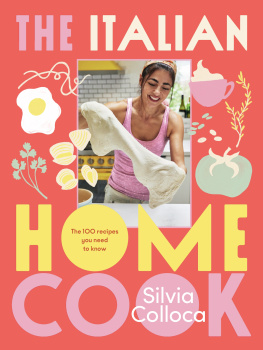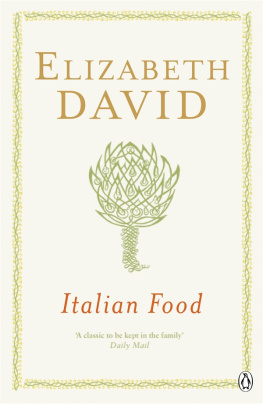
MADE IN ITALY
DAVID ROCCO
Photography by Francesco Lastrucci
Additional photography by Rutendo Sabeta


To my delicious
Emma-bunny & Giorgia-girl.
My inspirations.

Contents

INTRODUCTION
I always say that being Italian, cooking is in my DNA. I grew up in a house where going into the kitchen and helping out was completely natural and easy. Nothing was very fancy. We made traditional Italian food that my parents learned from their parents. Wed hang out together, cook together, eat togetherso the kitchen was also a place of real connection.
Some people think cooking has to be complicated to be good. But in my experience, the exact opposite is true.
When you write a cookbook, you put your philosophy and beliefs out there and hope that they resonate with people. Im always a little nervous about communicating my approach, because Im very visual and intuitive in the kitchen. At times I worry whether people will understand what a handful of this or a splash of that will mean and whether theyll be able to make it work for them. But thats part of the tradition and heritage of the kitchen that is important to me. Strict measurements dont work for me, and for sure cooking would be a lot less fun if I had to use them. And besides, Im not classically trainedIm Italian trained!
And so Ive been incredibly touched and encouraged by the responses Ive had to my first book.
Of course, you hope that what you write will inspire people to get into the kitchen. But what I didnt expect were the letters from people who said, You know, Im so sorry that I didnt write down my grandmothers or my mothers recipes. Ive missed their food. And your style of cooking is very similar. So I feel like Ive reconnected with their food and got a piece of them back in the process.
I make no secret about the fact that I am inspired by old-school, traditional, peasant-style Italian cooking. I say it over and over again: its simple, delicious and timeless.

So when I set out to write this book, I decided to go on a road trip through parts of Italy where I have friends and extended family. I wanted to reconnect with the people, places and food that excite me and bring to life some of the recipes I enjoyed along the way.
Heres the irony about Italy: Italianswho are known for their leading-edge style, their fashion and design, and who love making la bella figura and being peacocksare, when it comes to food, traditionalists. Simplicity in the kitchen is understood. Theyre not looking for a new spin on their pasta. They know what a good tomato sauce should taste like, and its respected and appreciated. Italy is a country of contradictionsbreathtakingly beautiful and yet seriously dysfunctional and disorganized. But when it comes to philosophy about food, regional preferences notwithstanding, Italians can all sit together at the same table.
And when you go looking for food in Italy, you inevitably meet great characters, too.
One day, after a morning at the beach, I had lunch at a friends restaurant in Ravello, on the Amalfi coast. We were joined by a friend of his, an intimidating-looking guy with a gruff voice. But when he found out that I was writing a book, his gruffness disappeared. He immediately pulled out his telefonino and completely rearranged his afternoon because he wanted to show me his Costiera Amalfitana. He called himself the Buon Gustaioa man of taste. So, to show that I respected his time, I said, Okay, va bene! Sono pronto. Andiamo! No, no! he said, raising his hands. We have to be civilized and do things right. First we have espresso. Then our digestivo. And then we go!

The next five hours was a marathon of generosity and food. We drove all over the region, making stops along the way at little shops where I met the people who make the best bread, the best homemade wine, salami, pizza, cookies, etc., etc. Everywhere, the Buon Gustaio was greeted like an old friendand because I was with him, so was I! He introduced me to the family who, he said, made the best fior di latte in the region. The third generation, the kids now running the business, wear Gucci and Prada, even to milk the sheep. They struck me as so quintessentially Italian, with their mix of cutting-edge fashion and their unwavering respect for the old-world style of making this luscious cheese.
And if this werent enough, the Buon Gustaio picked up his cellphone, called his wife and said, Butta la pasta. Abbiamo un amico che cena con noi. The phrase butta la pasta put a smile on my face. I had thought it was a Rocco thing, because it was the exact phrase my dad would use when hed call my mom as he was leaving work, so the pasta would be ready by the time he got home.
Entering the Buon Gustaios house was like walking into my moms or my aunts. His wife greeted me with open arms. We sat at the table for hours, eating fantastic food inspired by Amalfitana and Neapolitan traditional cooking and then engaging in hours more of conversations about food.
Not only are Italians proud to feed you, but theyre proud to share recipes and techniques. It doesnt matter if theyre chefs, lawyers or government workers. Most of them love food, know their way around the kitchen and have an opinion on how things are done. Theyre schooled by the experience that comes from generations of families cooking and eating together.
Italians are famously regional in their attitudes, and youll really see this in the way they make even signature dishes of a particular area. Sometimes theyre provinciale to a fault and will be absolutely closed-minded about a dish thats made differently in a town just eighty miles away. One of the blessings of my job is that I travel all over Italy and experience the foods of many different regions, so I have an openness that many Italians dont.
Let me tell you a story about Italians and regional bias: Caponata is one of the quintessential signature dishes of Sicily, so youd think there would be a definitive version. When a successful Northern Italian chef was about to open a new restaurant in the Sicilian port town of Sciacca and wanted to offer caponata on the menu, he wanted to make sure it was autentico. He asked a friend of mine who works in the food industry if he could come over and learn how to make the familys caponata.

With typical Sicilian hospitality, my friend said, Of course! and invited his sisters and his aunt over to the house as well to meet the chef. First there were introductions and a discussion; then, very quickly, someone gave a recipe. This was followed by someone else correcting them, and then another opinion, and within a very short time, the room had become so loud and so full of opinions that even the chef was worked up.
Next page
















